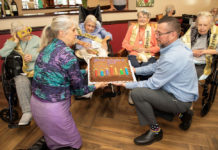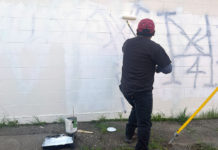- Police say there are as many as 3,000 gang affiliates in Sonoma
County
by NATHAN WRIGHT, Staff Writer
If you live in the North County, chances are that you’ve seen
the signs. Perhaps it was in the form of a red 14. Perhaps it read
X4, Norte, Puro Norte or Nuestra Familia. If you’ve come across
this graffiti, scribed on just about anything, you’ve seen the
presence of the Nortenos, north county’s largest gang.
In the past six years, the Healdsburg Police Department has
identified 435 different gang members, many visiting from outside
areas, inside of Healdsburg, according to HPD Sergeant Kevin Young.
“That’s a lot for a town this size,” he said. “They use the
graffiti to mark their territory.” According to the Sonoma County
Sheriff’s Department gang unit, Sonoma County has between 1,800 to
3,000 individuals who are gang affiliated. They have also
identified close to 700 different gang participants in Windsor,
many of whom are only visiting the area.
While many of the Nortenos are from Healdsburg and Windsor, many
also travel north from the Santa Rosa area. “Santa Rosa has been a
hotbed of problems,” Young said. “We’ve seen many of the same
people up here.”
The Nortenos, an evolution of the infamous Nuestra Familia
prison gang, use red as one way of identifying themselves, police
officials say. They also use the number 14, which represents the
14th letter in the alphabet (N), and a variety of other words
including Norte (north) and Puro Norte (pure north). The color red
and these symbols are observed in their clothing, on their
belongings, and most noticeably on the walls and structures they
tag, according to police.
Many of these gang members are between the ages of 15-25, and
many were recruited in junior high. How many came from Healdsburg
and Windsor schools is not clear, but this is certain: the Nortenos
recruit directly from the schools, and at a much younger age than
most would expect. “The junior high is a farming ground,” Young
said. “They definitely use our school district as recruiting
grounds.”
Many Nortenos end up leaving, or are removed from the area, due
to arrests, violent crimes, or because they realize that the gang
isn’t good for the individual. Because of short memberships, gangs
must recruit to stay alive. “If they don’t recruit new members, the
gangs will die,” Young said. “The gangs are always in a recruiting
mode.”
The Nortenos are opposed by the Surenos, who have gone from
almost a non-factor to serious opposition in the past decade. The
Surenos identify themselves with the color blue and the number 13.
The thirteenth letter of the alphabet is M, which Surenos use to
represent Le Eme, a prison gang with influence similar to Nuestra
Familia.
For years, the Surenos were primarily a Southern California
gang, located mostly below Bakersfield, according to Young. “For
years, our red gangs didn’t see a lot of opposition,” Young said.
“The Norteno’s obviously didn’t want the Surenos up here. That was
the beginning of our problem.”
The two gangs have battled each other ever since, with the
Nortenos initiating most of the conflict in the North County,
according to police. The battles between the two gangs can be seen
on their graffiti, with both gangs crossing out each others work
with the opposite color, often leaving their own work.
School staff see gang activity working its way through the
schools. “We have a junior gang called SSP that’s recruiting people
in the sixth-grade level,” said Jan Burnham, a counselor at Foss
Creek Elementary School.
The Healdsburg Unified School District and the Windsor Unified
School District have both taken steps to discourage gang activity
in its schools, both enforcing a dress code that limits the amount
of red worn by students. The Sheriff’s Department sees the dress
code as one of the key’s to gang prevention in the school
system.
“Students can’t wear gang-related attire,” said Windsor High
School Vice-principal Patricia Law, who believes the efforts made
by the district are having a positive impact on the situation.
“It’s much better this year. I’ve noticed a difference.” Law is
part of a gang task force at WHS, offering counseling and guidance
to at-risk youths. The team consists of three administrators, a
student advisor, two campus supervisors and a resource officer.
North County schools have also enlisted the help of
organizations like Circuit Rider Productions, who have sponsored
programs like GRIP (Gang Risk Intervention Program). Steve
Velasquez, the north county GRIP coordinator, visits 90 kids a week
who have been labeled “at risk.” “We’re all working together for a
cause and that’s to have a healthy community in the north county,”
he said. “Let’s not look at labels, there’s enough people labeling.
Let’s see people for who they actually are.”
Velasquez mentors a program called TEC (Teen Empowerment Crew),
designed at pulling kids together in a positive environment away
from gangs.
The group discusses gang issues. Some question the school
district’s methods at quieting gang influence. “So you won’t be
wearing the colors in school, but outside of school you’ll wear
them anyway,” said TEC member Jenny Sweeden. Another TEC member,
Myron Thomas, identifies reasons why youths join gangs. “They want
to get attention,” he said.
There are many reasons why kids join gangs, and most are in
agreement that the principle reason lies to unmet needs. Whether it
be power, popularity, acceptance, a family, drugs or alcohol,
authorities like Velasquez say that the allure of a gang can be
quite strong for a youth who is missing something in his or her
life.
Both Healdsburg and Windsor High School report a recent calm on
the gang front. “We’ve had very few gang-related problems,” said
HHS Vice-principal Tom Kirkpatrick. “We’ve had no expulsions this
year.” Kirkpatrick says that they have had some problems with
graffiti, but the school has been quick to take car of it. “As soon
as we see it, it’s gone,” he said.
Officer Ben Tenhave, the school officer at WHS and a member of
the Windsor Police Department, reports similar experiences. “It’s
quieted down a bit,” he said.







